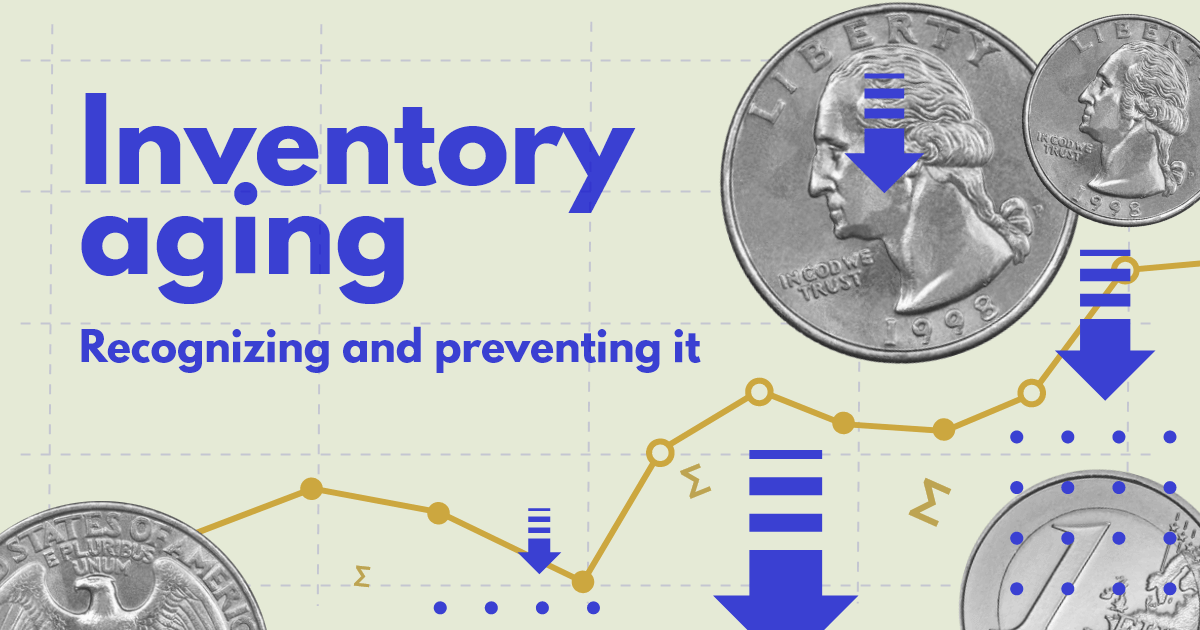Sales forecasting
and inventory optimization
Become a retail mastermind you always wanted to be.
Become a retail mastermind you always wanted to be.
By: Jul Domingo
It’s a situation you’re familiar with.
A full warehouse, but the company isn’t making profits as expected. What’s causing the hold-up?
High overheads and shrinking profit margins are common outcomes of inventory aging. The best way to sell these products is to lower their price and reduce your profit margin. But that’s only a short-term fix.
Discovering aging inventory before it becomes dead stock is the best course of action. But walking up and down the aisles of your warehouse won’t help you figure out what these products are.
Inventory aging or aging inventory describes stocks that barely move. In theory, the ideal inventory age can be a week, a month, or even up to 90 days from the supplier’s delivery date. Conversely, most companies consider items that sit for more than six months or 180 days to be dead stocks. Aging stocks fall in the middle of this spectrum.
As difficult as it may sound to accept that some products aren’t selling, it pays off to face the facts. Otherwise, you’ll continue to deal with aging inventory, which comes with a different set of consequences, such as:
Poor inventory control: Keeping your inventory in check allows you to monitor the life cycle of stocks from storage, management, to distribution. If no one oversees the aging of stocks throughout that cycle, it makes them more prone to obsolescence. It can also result in poor warehouse organization, decreased productivity, and incorrect inventory balances.
Excessive storage costs: The older your stocks are, the more you’ll have to pay for storage and utilities. If there’s a need to free up storage space, looking into inventory aging can help identify slow-moving items. This gives you the opportunity to free up space that could have housed additional fast-moving items.
Increased costs for quality maintenance: These costs can include repairs, warranty claims, and handling customer complaints. Without the insight of inventory aging reports, extra costs are unavoidable to ensure a top-notch customer experience
Loss on inventory write-offs: You can’t keep aged stocks forever—eventually, you’d have to write them off as an expense account in your balance sheet. It’s a required procedure to reflect the loss on inventory and its negative impact on the net income. To avoid this, you can use the inventory aging report to replenish your stocks in smaller and more frequent order quantities.
Inventory aging reports detail the materials or products that have been stocked at specific locations for n-number of periods. It shows unproductive items in one list, based on the average turnover per day. There is full transparency since details about the items include their aging period.
The purpose of this is to reflect the different shelf lives of different products. With a comprehensive retail inventory strategy, you get a more accurate inventory age benchmark. If you arrange the days’ range in columns (e.g., 0-30, 31-60, 61-90), list down all product items in rows, and add their purchasing information, you’ll get a basic aging report.
It’s also possible to automate the process. For instance, Inventoro automatically gives you a lowdown of your aging inventory once you connect it to your system.
Aging inventory could force you to hold sales often, which can hurt your business or at best, leave you at breakeven. An inventory aging report serves as a guide for ensuring that every purchase brings maximum value and prevents the cycle of inventory aging.
More importantly, it reveals stocks that incur more storage and maintenance costs, allowing you to cut back on them. An inventory aging report can help you:
Maximize cash flows: This report highlights slow-movers and the fast-movers in your product portfolio. Referring to it allows you to allocate your limited cash to fast-moving items you can sell in a short amount of time and get rid of the stagnant stocks that are discreetly leeching off your cash flow.
Minimize excess stocks: The report on inventory aging identifies all the products that often end up as excess stocks. Using that information, you uncover and resolve the root cause of the excess. If, for example, excess stocks are the result of poor forecasting, you’ll learn from your mistake and adjust your forecasting going forward.
Improve purchasing decisions: An inventory aging analysis is your blueprint to remove any inefficiency in your purchasing methods. For example, if the poor quality is contributing to your product surplus, you can choose a new supplier.
Optimize inventory strategies: Inventory aging reports shows the optimal structure of your inventory—or simply put, the inventory level that saves you money and boosts revenue. Knowing the average age of inventory is extremely valuable if you’re planning and allocating your purchases. Plus, it encourages you to focus on long-term procurement strategies that can grow your business, such as product innovation.
Holding aging inventory is a huge expense in your business, and leaving them neglected can exacerbate the problem. Here are four techniques to leverage your inventory management by detecting your aged stocks.
In a manual inventory system, you have to record all the movements of stocks on a piece of paper. This process starts with the supplier’s delivery to the point of sales—and all the transfers that happen in between. You can then estimate the average age of inventory based on your observation of their life cycle.
Manual tracking of inventory aging is the least expensive on this list. But this method is inefficient, especially if you handle hundreds of transactions each day. It also consumes too much personnel time that they could otherwise spend on more important tasks.
FIFO’s literal meaning says it all: the first items that go inside the storerooms are the ones to go out first for sale. This storage and recording method requires you to list down all the individual purchase dates of each item. This way, you can detect and get rid of the aging inventory that doesn’t move within the duration of its usual flow.
FIFO is a common method for supermarkets that sell perishable products with expiry dates. But it’s difficult to maintain without AI intervention because of its complexity.
Spreadsheets, particularly MS Excel, are famous for small businesses in tracking inventory aging. This process combines manual data entry and automated computation to find out the average age of inventory. But this won’t work if your staff isn’t proficient enough in formulas and navigation to ensure the report is accurate.
This approach is limited in several ways, including its inability to provide real-life data to the inventory team. Without automation, this task is also tedious and prone to error. If for instance, one employee receives the shipment but does not update the sheet, another employee might place a new order, leading to excess stock.
Inventory management software performs all the functions above with an added bonus of automation. With it, you can track all ins and outs and extract the inventory aging reports in real-time. The system updates balances 24/7, so it’s impossible to overlook the slow-moving items.
When using software like Inventoro, you gain access to the list of fast-movers and slow-movers in one click. It also excludes your aging inventory right away in your next replenishment, making your business more scalable in the long run.
Inventory aging can result in dead stocks if left unattended. At this point, the slow-movers are already unrecoverable. It’s just a matter of donating them or selling them at a discount to recoup some money. This is especially true for stocks with a short lifespan, such as fresh produce, or like the example below–plants:
Source: Twitter
It doesn’t have to reach this point/ Below are three strategic ways to minimize financial losses that stem from inventory aging.
Poor forecasting is the primary reason for aged stocks, resulting in significant losses. Let’s say, your company stocks up larger quantities than usual based on a faulty calculation or a simple assumption that demand will rise. If the reality doesn’t meet that assumption, then you’ll end up with excess stocks which are basically pre-aging stocks.
Demand forecasting only works if it’s accurate. Make sure you only purchase what you need by relying on powerful algorithms and analytics, especially during seasonal peaks like Black Friday and Christmas sales.
Another way to avoid inventory aging is through proper product segmentation that allows you to sift through the best performers and the worst performers (and everything in between). Using your sales and purchasing records, you’ll be able to identify your best-selling products. Alternatively, you can automate that step using an inventory tool.
Inventoro separates your product portfolio using the ABC analysis. It allows you to extract the winners-chasers-losers segmentation report to invest only on the most profitable products. This can prevent your slow-movers from ending up on your replenishment list right away.
Monitoring stocks in real-time can prevent inventory aging in various ways. First, you won’t have to replenish your stocks if your stock levels are still high, avoiding overage. Second, you resolve stagnant balances promptly and reduce aging stock.
For instance, once you integrate your system with Inventoro, you can see the age of your inventory right away. With accurate lead times and timely data-based reports, you can seamlessly optimize your inventory in the long run and get rid of your aging inventory for good.
Inventory aging is inevitable and a common bottleneck in your company’s profitability. But you can conquer it. With an aging report and proactive smart measures, it’s possible to get rid of your aged stocks—100%.
Access Inventoro for free for 14 days and get an inventory aging report immediately, which will enable you to eliminate underperformers and create a more impressive product portfolio.
Become a retail mastermind you always wanted to be.

